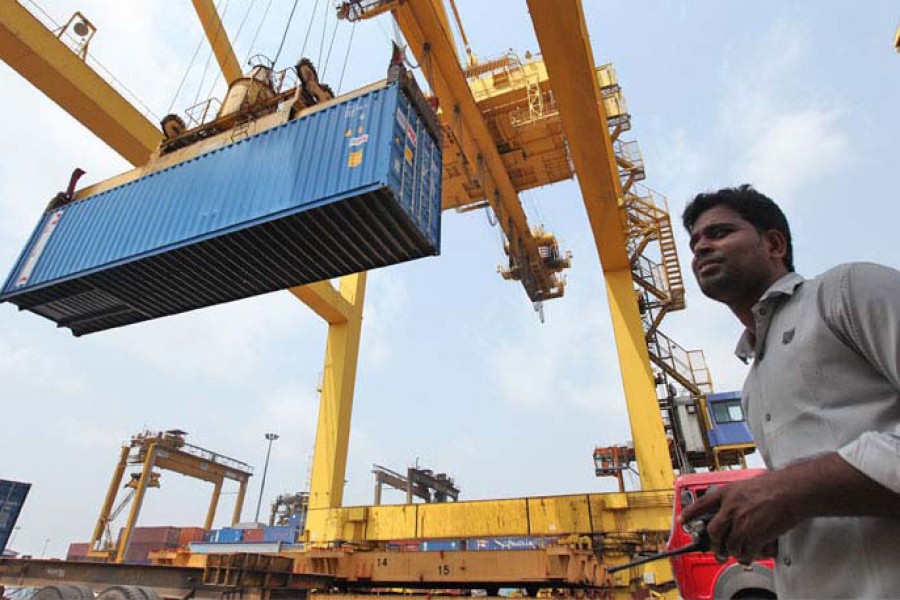Not market, scant export basket troubles Bangladesh: Experts
Free trade access to largest market mostly missed, remedies overlooked
China offers Bangladesh zero-tariff entry for enormous 8,930 products

Published :
Updated :

Bangladesh miserably fails to avail the enormous opportunities the world's largest market, China, has offered, mainly due to a deep-seated crisis in product diversification, competitiveness, and inept strategic execution, experts say.
China has granted Bangladesh zero-tariff entry for 98 per cent of its tariff lines or 8,930 products-- a bonanza of benefit in effect since September 1, 2022, under WTO provisions.
Yet, this diplomatic victory has failed to translate into commercial success, leaving a yawning bilateral trade gap worth US$16 billion, they note to expose export sector's look-west craze and government's lacking in guiding targeted production and marketing.
The hiatus between imports and exports persists over time--largely unattended--raising critical questions about Dhaka's preparedness for the upcoming graduation of Bangladesh from least -developed country (LDC) status, trade sources and experts deplore.
Approximately one-fourth of Bangladesh's total commodity imports come from China--a country that dominates global supply chains of basic products, including chips for the western economies.
According to data from the Bangladesh Bank and Export Promotion Bureau (EPB), the bilateral trade volume surged to approximately $17.3345 billion in the last 2024-25 fiscal year (FY) from $3.5 billion in FY 2008-09.
However, the growth happens to be entirely one-sided. Imports from China hit $16.64 billion, while exports from Bangladesh fetched a mere $694.49 million. Export volume is stagnating well below $1.0-billion mark.
Experts pin the blame on a confluence of strategic and structural failures, arguing that the country's weak competitiveness is negating the duty advantage.
Bangladesh's reliance on ready-made garments (RMG) proves to be a liability on the Chinese market.
Professor Mustafizur Rahman of the Centre for Policy Dialogue (CPD ) states unequivocally, "We have failed to diversify products to match the diverse and high-quality demands of the Chinese consumers."
He notes that RMG, Bangladesh's core strength, is not what China imports extensively.
Trade-specialist Dr Mostofa Abid Khan reinforces this, explaining that major garment buyers are big Western retailers, and few, like Walmart, are top players in China.
"Expansion of export to China requires marketing in China through contacting top retailers in China," he suggests as a remedial measure.
The zero-rated tariff benefit is conditional upon meeting 40-percent local- value -addition requirement under the Asia -Pacific Trade Agreement (APTA). This often disqualifies products heavily reliant on imported raw materials.
Dr Khan points out that the actual competitive edge is marginal, with the duty concession translating to only a 6.7-percent margin of preference, which is insufficient to outcompete rivals like Vietnam and Italy.
The "lack of necessary agreements, the slow pace of taking initiatives, and the inability to understand the market demand" further undermine export growth to China.
The most devastating critique focuses on the domestic environment, which chokes off the investment necessary for diversification and quality improvement.
"The loss of competitiveness stems from the existing environmental constraints on business and investment within the country," mentions Professor Mustafizur Rahman.
These constraints act as massive deterrents, despite Chinese net foreign direct investment (FDI) rising to $1686.24 million as of the FY2024-25.
He also underlines some internal issues, including shortages of gas and electricity, high cost of doing business, crippled turnaround time at the ports and poor functioning and failure of the 'Single Window' system.
Experts, including trade specialists and business leaders, have put forward several steps for Bangladesh to leverage the Chinese market.
They have suggested expanding exports beyond RMG into sectors like pharmaceuticals, light engineering, leather goods, shipbuilding, seafood, ICT services, and high-quality diversified non-RMG products and promptly signing any agreement or FTA with China to secure long-term market access and favourable terms beyond LDC graduation.
Also recommended developing a long-term action plan to recognize and understand the sophisticated and diverse demands of Chinese consumers and the dynamics of the market.
As another major measure the experts mention is attract Chinese foreign direct investment to boost domestic production capacity and leverage the duty-free access aggressively.
Dr Khan stresses the urgency of enhancing product quality and standards, and focusing targeted marketing by contacting top Chinese retailers. .
Recommendations also include removing internal investment-and business-environmental barriers to improve overall competitiveness, productivity, and efficiency priority.
The Bangladesh-China Chamber of Commerce and Industry (BCCCI) former general secretary Al Mamun Mridha believes the key to increasing Bangladesh's exports to China is strategic product diversification and producing goods in alignment with the demands of the Chinese market.
He firmly states, "It is difficult to expand the export market in China by focusing on RMG."
Mr. Mridha highlights an immense potential of marine resources on the Chinese market, saying, "We must extract more of our Blue Economy resources. This move will bring down the price of such items. We will be able to export to China at a competitive price."
Additionally, he has identified the leather industry as an important player for China trade and urges local traders in this sector to work aggressively to capture the market of around 1.5--billion -strong population.
A senior official of the commerce ministry bills the Chinese market access as a generous gift that is currently being squandered. "Without drastic and immediate action to address the structural flaws at home, Bangladesh risks entering its developing- country status with a major trade relationship defined by chronic dependency."
Mentioning a wide-scale demand for Bangladeshi pharmaceuticals in China, Al Mamun Mridha believes that government-to-government (G2G) initiative will further accelerate exports of the promising sector to the world's second-largest economy.
rezamumu@gmail.com


 For all latest news, follow The Financial Express Google News channel.
For all latest news, follow The Financial Express Google News channel.